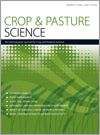This review discusses the role of zinc (Zn) in chickpea biology and examines Zn dynamics in soil and in chickpea-based cropping systems. It considers breeding strategies to develop Zn-efficient varieties, biofortification, and agronomic approaches for managing Zn deficiency in chickpea. Simple, efficient and cost-effective strategies involving different application methods (soil, foliar and seed Zn treatments) for improving grain yield and grain Zn concentration in chickpea are also covered.

Crop and Pasture Science
Volume 71 Number 3 2020
CP19421Effects of plant population and row spacing on grain yield of aerial-sown and drill-sown rice
For aerial-sown rice, maximum grain yield (up to 14.9 t ha–1) was always achieved with a minimum plant population of 100 plants m–2, and likewise for drill-sown rice provided the row spacing was ≤27 cm. Plant populations as low as 30 plants m–2 were able to achieve grain yields >12 t ha–1 but only when the plants were uniformly distributed. At a population of ~100 plants m–2, the impact of plant-stand distribution was negligible.
CP19421 Abstract | CP19421 Full Text | CP19421PDF (848 KB) Open Access Article
Use of optimal breeding methods to improve the ability of canola to withstand abiotic stress will be essential in a changing climate. This study illustrates how whole-genome predictions can be leveraged by breeders to enable improved genetic gain for complex traits such as abiotic stress tolerance. Application of this breeding methodology will enable the continued improvement of canola by breeders within a changing environment.
CP19387 Abstract | CP19387 Full Text | CP19387PDF (1.3 MB) | CP19387Supplementary Material (230 KB) Open Access Article
CP19425Genome-wide association mapping and candidate gene analysis for water-soluble protein concentration in soybean (Glycine max) based on high-throughput single nucleotide polymorphism markers
 and Yingpeng Han
and Yingpeng Han 
Water-soluble protein concentration (WSPC) of soybean affects the quality of soybean-derived food and the appearance of soybean products. In the present study, a representative soybean population of 178 elite accessions was selected and used to determine quantitative trait nucleotides of WSPC via a genome-wide association study. Identified loci along with eight candidate genes will be of great value for further functional analysis and marker-assisted selection of WSPC in soybean.
There are few studies on soybean lodging at present. We examined the mechanical properties associated with soybean lodging through plant force analysis, and we propose using the lodging-resistance coefficient to evaluate resistance of soybean to lodging. This study provides a new method for predicting lodging resistance in soybean, and it could be used as a selective breeding tool.
Citrus fruits are important horticultural products globally, and citrus canker (caused by Xanthomonas citri subsp. citri, Xcc) is a dangerous disease worldwide owing to a wide host range, susceptibility of all citrus cultivars, and high prevalence in citrus-growing regions. We tested strains of two pathotypes of Xcc for virulence on leaves of three Citrus species, and for growth on eight species of citrus weeds. Xcc can survive on most of the weeds used in this study; therefore, disease-management programs should be directed to control and eradicate these weeds.
In this study of Brassica tournefortii, a problematic weed in no-till production systems of northern Australia, seeds were shown to persist for a short period on the soil surface and emergence was high from the soil surface. Brassica tournefortii could compete with chickpea and has a tendency to produce sufficient seeds under water-stress condition for reinfestation. A strategy of diligent control of seedlings during a 6–12-month fallow could exhaust the seedbank, resulting in a minimal weed problem in the following crop.
CP18357Influence of protodioscin content on digestibility and in vitro degradation kinetics in Urochloa brizantha cultivars
We evaluated the quality of five Urochloa cultivars during the four seasons of the year. These grasses contain an anti-nutritional compound called protodioscin, which can reduce feed quality to ruminant animals when consumed, causing metabolic disturbances and resulting in intoxication. The results showed that all cultivars had higher protodioscin contents in autumn and reduced nutritional quality.
CP19156Seasonal alteration in sward height of Marandu palisade grass (Brachiaria brizantha) pastures managed by continuous grazing interferes with forage production
Changes in sward height of pastures according to climatic seasonality alter forage production. Reducing the sward height of Marandu palisade grass pastures continuously stocked in June (when light, temperature and water are limited) contributes to renewal of the tiller population during the subsequent growing period (November–December) when availability of resources and conditions determined by climatic factors are favourable, thus improving forage production. This strategy can also be applied to supply additional forage during the period of natural shortage.
CP18369Effects of nitrogen fertilisation and irrigation on seed yield and yield components of signal grass (Urochloa decumbens)
The highest nitrogen rates produced the best seed yields. The highest N rates increased reproductive tiller density, potential floret density and seed number per area in both crops, while crop phenology, harvest index, seed weight and tiller weight was unaffected. Nitrogen also significantly increased plant biomass per unit area in both crops.
CP18369 Abstract | CP18369 Full Text | CP18369PDF (769 KB) Open Access Article



